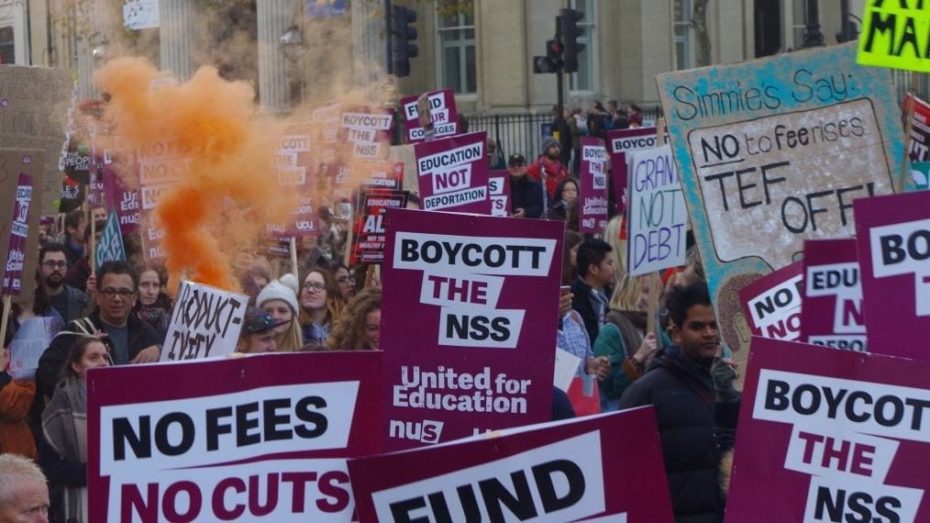The boycott of the NSS by students’ unions across the UK appears to have borne fruit for some.
NUS claimed that around 25 students’ unions were participating in the NSS boycott, a policy passed at its annual conference in 2016. It will likely be celebrating the fact that some universities have failed to reach the necessary completion rate in order to have a publishable overall NSS score.
According to the press release from HEFCE, twelve higher education institutions did not secure the response rate necessary for their data to be published at institutional level. There is, however, publishable data for some subject areas within these providers, which will be made available on Unistats.
As far as Wonkhe can tell, those twelve institutions are as follows:
- University of Manchester
- University of Bristol
- University of Oxford
- University of Cambridge
- University of Sheffield
- University College London
- King’s College London
- University of Liverpool
- School of Oriental and African Studies
- Royal Conservatoire of Scotland
- Royal Central School of Speech and Drama
- Courtauld Institute of Art
Of course, some of these have missed out through having a small eligible student body, but there is clear enough evidence for the effects of the NUS-led boycott.
It’s a collective issue
It’s a big day for the large research-intensives; the majority of universities missing from the data are from the Russell Group. Heavyweights like Oxford and Cambridge are no-shows in this year’s data, as are Manchester, Bristol, and University College London. Other Russell Group universities did have students’ unions promoting the boycott – yet these efforts appear not to have succeeded: Warwick and the London School of Economics still feature in this year’s data. LSE’s notoriously poor performance in the NSS saw it fall further, this year by one percentage point.
Other unions which heavily promoted boycotting the NSS, but failed to convince enough students to eschew the survey, include Reading, Sussex, and the University of the Arts London. Unlike previous boycotts held years ago by the University of Cambridge and the University of Warwick, among others, this represents more of a national movement against the NSS than ever before – and more of a collective problem for the sector going forward.
So what?
While for student activism, there is much to be admired in the success of both the NUS and students’ unions managing to engage students in what can be a tedious and wonkish issue, the impact of the boycott may be short-lived. For now, there is likely to be a good headline story in students turning up their noses at some of the most prestigious institutions, and attempting to disrupt Jo Johnson’s flagship policy of TEF. Yet, in order to fully disrupt TEF and prevent the use of the NSS data in its calculations – by ensuring that no data is available – the boycott will need to succeed for a further two years.
Whether that political energy can be sustained in the ever-changing student population is yet to be seen, but it’s a definite challenge that students’ unions will be looking at. Changes in political leadership also mean that it is possible that future students’ union officers will not want to support the boycott to the same extent as this year’s cohort.
Further, changes at the top to the leadership of NUS means that the new ‘moderates’ elected to lead NUS earlier this year are unlikely to be keen on continuing to pursue a boycott at a national level. While the perceived success of this boycott will galvanise those on the left of NUS, the mood among student unions appears to have shifted, with the national conference this year choosing not to hear a debate on the boycott, and going even further to vote down an attempt to send it to the National Executive Council (NEC) for consideration. Revisiting the boycott would represent a considerable ideological shift for those elected – so it would be unwise to anticipate a major campaign for the next academic year on the matter.
The role of the institution in attempting to undermine future boycotts is also to be considered. Students’ unions might find their block grant negotiations subject to uncomfortable conversations around the NSS, particularly when it comes to the funding and financing of campaigns work. Marketing departments are also likely to be drawing up new plans for how to counter the efforts of unions, probably through bribes such as Amazon vouchers, offers of departmental parties, free iPads and printing credit.
Yet perversely, the results of this year’s boycott could be cause for celebration for some vice chancellors. For universities such as Bristol, which has performed poorly in the NSS in recent years, it has given some cover from the public embarrassment which accompanies poor results. That in itself poses a new challenge for the OfS – in the context of political action being taken against the NSS, should universities which fail to reach the quota for completion be punished for poor engagement with students? Else, it runs the risk of other institutions with poor scores feeling less incentivised to push the NSS, especially if it does not have an impact on the TEF rating.













A wider consideration would be how will league tables be impacted by the lack of NSS results? Could this mean that top spot goes outside of the Oxbridge elite? The Guardian used to triple count the NSS and the double…
Yoda, a wise point. One would hope that it would be disruptive to that extent.
I’ve been following the 2016 US presidential election and aftermath closely, particularly the shady opinion-shaping practices through social media, bots and the subversion of other, legitimate campaigns. It’s clearly coloured my thinking about everything else and turned me into a black-hearted cynic, because, like Yoda (above), when I saw this year’s sector-wide drop in satisfaction scores it occurred to me that this was a very good year for institutions NOT to have hit the necessary completion rate.